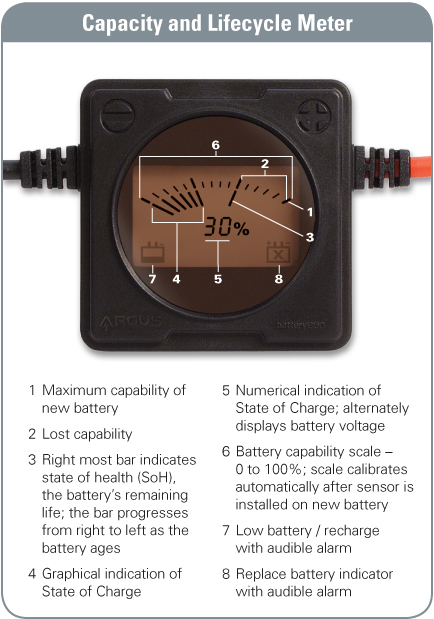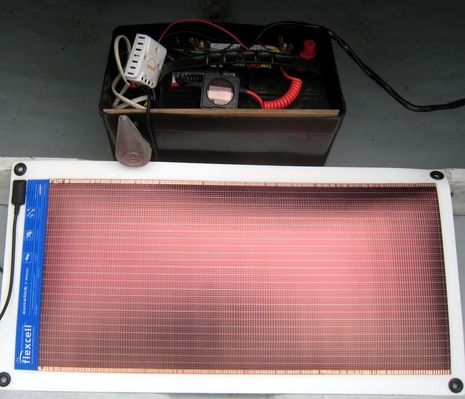Battery Bugs, new monitoring tech?
Lest you think I’m just about big diesels, check out the good Annie G.’s auxiliary propulsion power system. Years ago I bought the cheapest Minnkoda electric trolling motor I could find (visible on Annie here) and moved the control switch to that battery box where the ‘custom’ wooden shift/throttle gives me five speeds in forward and three in reverse. None exactly makes the 18′ iron-keeled sloop jump, but the rig is handy for getting into the Camden Inner Harbor slip I often use. But I always had a problem knowing if I had enough charge to use the motor as needed. That was neatly solved last summer with the addition of that solar panel and most especially the Argus Analyzer Battery Bug…
Argus makes DCM model Battery Bugs for applications like Annie G, and STM models for batteries used mainly to start engines, and they claim to use innovative testing technologies in both cases. The test for deep cycle use is called Large Pulse Resistance, which an Argus representative told me is similar to load testing the battery every minute (and keeping a history of same), while “Crank-Check captures the voltage profile of the battery during the starting sequence.” I don’t know enough about such matters to opine on how these truly compare to other battery monitors out there, but my knowledge of, and confidence in, little Gizmo’s starting battery and Annie G’s solar system was vastly improved by them last season. And both Battery Bugs held up well to my abuse. But they don’t make much sense on a bigger boat like the new Gizmo — which has, God help me, four battery banks all tucked into the inhospital engine space — because they’d be hard to look at, and I’d never hear the alarms. But I do wonder if the testing technology might become a networkable sensor, and said as much to Argus. Over in the forums, our guy Russ is not happy with his bigger boat battery monitoring, and I’m wondering if any of you are?
















If this little bug works it could be hand if one can gain access to it because the chord restricts placement of the display at a max of 18″ from the battery terminals. This means it’s probably not viable for most marine applications where batts are placed low, covered and out of sight. This makes sense for some applications however, where fixed mounts would not.
I find the Link20 to be inaccurate for multiple reasons as far as “capacity” and so forth. But I believe the volt meter is quite accurate and probably the ammeter as well.
Batteries are difficult to manage because they have a normal life span degradation and this is affected by environment and how that are used, charged and so forth. A battery is not like a tank of water which you can read it’s volume and know how much you need to out back in where you are dealing with a fixed volume etc.
Still waiting for better battery technology.
Dan shares positive Link 20 experience, and install advice, on the forum:
https://panbo.com/forum/2009/03/battery-status—does-anything-work.html
Also, Amazon has Battery Bugs:
Battery Bugs at Amazon
I’m trying to sort this out. The Argus approach seems good. I like that their web page gives an explanation for techies. Some fun with PR displays: The above photo shows the SoC as 30%. That’s really low, even for a deep cycle battery, but the low-battery icon is not on (or is it?). The state of health is down 30%, but the replace-battery icon is not on (or is it?) — operating between 60% and 50% hardly makes hauling that battery around worthwhile. Counting tick marks, each minor tick is 6%, each major tick is 30%, for a total of 90%. What happened to the other 10%?
The SmartGauge that Russ mentions also seems very good from the details on their website, but they don’t give quite enough details about how it works. There is no shunt, so it can only measure voltage (which is not enough, as they say). They say it does some tests at certain points. Perhaps the tests are similar to the ones the Argus makes.
http://www.smartgauge.co.uk/smartgauge.html
Hi, The SmartGauge is very well regarded in the UK although the major user base is for canal (river) boats (narrow boats as we call them).
I believe that the SmartGauge operates by taking conductivity measurements of the acid electrolyte using AC to measure the conductance. The conductivity relates to the acid concentration – as does the specific gravity – so it’s like taking the average SG readings of the cells forming the battery bank being monitored. This information is combined with voltage information and somehow this can be turned into a fairly accurate state of charge measurement.
Hugh